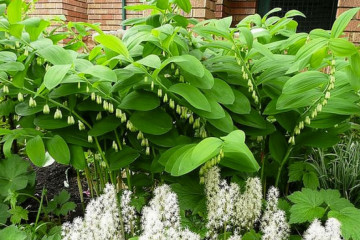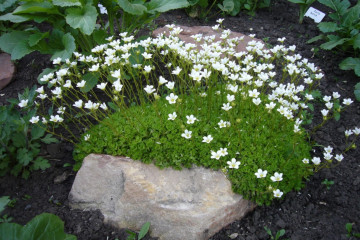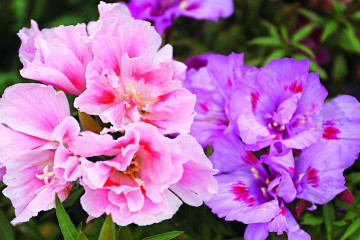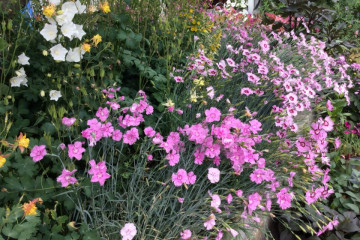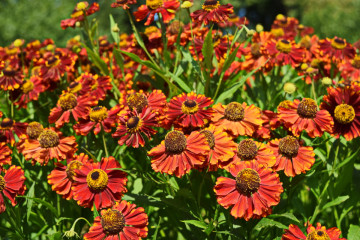Gerberas - what are these flowers, planting and care in the garden
Content:
Florists use gerberas to compose semantic compositions. The meaning of the flower is innocence and trepidation. A bouquet of gerberas means a declaration of love. And the description of the gerbera can be found even in classical literature. But the most interesting thing is that any gardener can grow these flowers.
Gerbera - what is this flower
This perennial plant belongs to the Astrov family. Gerberas are a Compositae species native to South Africa and Madagascar.
Dark green leaves are collected in a rosette. Long bare stems grow from its center, the height of which can reach 70 cm. At the end of the stem, when fully ripe, one flower blooms. The size varies from 5 to 30 cm, depending on the variety.
Gerbera flowers look like chamomile.
Types and varieties of garden gerbera
To understand what gerberas are, you need to understand the existing variety of varieties and species.
Gerbera is a flower that is most often represented by hybrids in gardening. They were bred by crossing Jameson's gerbera and green-leaved gerbera. What color the inflorescence of the plant will be painted in depends on the selected variety.
Vincent and Arendgost are representatives of the hybrid gerbera. A distinctive feature is the black core. The most decorative representative of this species. Bright gerberas of these varieties can have a wide variety of shades.
The varieties Rosalyn and Lancaster are perennials, colored pink. They have long narrow petals, flowers 6-8 cm.
Large red flowers grow in the following varieties: Aldebaran, Veronica, Peter, Pluto, Romeo. The stem of these species is quite long - 40-50 cm.The flowers are medium-sized - 10-12 cm.
Marlene and Polaris varieties are represented by snow-white flowers. They have the maximum similarity to chamomile.
Varieties Alisa, Orange Beauty, Zeltane, Mirage are colored bright orange. The petals look like tongues of flame, are unevenly located - shorter in the center, then lengthen.
The varieties Tamara, Helios, Elegant have yellow flowers. The stem of these species is shortened, the flower is large - 12-15 cm.
Also, gardeners have a division of gerberas according to external signs:
- flowers with narrow petals and small flowers (varieties Aldebaran, Alcor). The plant does not exceed 50 cm and flowers are formed up to 9 cm;
- broad-leaved species. These include Delios, Saturn. Flower height - 70 cm, bud size - 15 cm;
- varieties with terry narrow petals (Sonya, Viola, Kalinka);
- the largest representatives with narrow petals are Migar, Jupiter.
There are many more types and varieties that you should pay attention to when choosing a decoration for your site.
Planting and growing gerberas outdoors in the garden
To create favorable conditions, it is necessary to know how gerberas grow in their natural habitat. A heat-loving plant does not tolerate any temperature changes. High humidity is detrimental to the root system of the flower.
If the plant is not transplanted in a timely manner into more suitable climatic conditions, it will become an annual.
Sowing seedlings
Gerberas are flowers that should be grown outdoors in seedlings.
When self-harvesting seed material, existing flowers must be artificially pollinated.
When using store-bought seeds, it is important to pay attention to the expiration date printed on the packaging.
Sowing seeds for seedlings can be carried out from January to March. For further planting in the ground, the best time is March, for indoor representatives the entire period is suitable.
How to prepare the soil
The soil for planting should be as light and nutritious as possible. For self-preparation, you must mix:
- turf soil (2 parts);
- sheet land (1 part);
- humus (part 1);
- river sand (1 part).
Planting gerbera in open ground
Timely planting of a flower in a personal plot is a guarantee of long flowering. The most favorable time is May - June. The transplant site must be well lit. In the shade of a gerbera, even with proper care, flowers do not form.
For open ground, it is necessary to choose the strongest and strongest representatives.
The site is being prepared in advance. Before disembarking, you must complete a number of activities:
- all weeds are removed;
- peat and sand are added to the ground;
- soil acidity should correspond to a neutral indicator;
- the hole for planting should be much larger than the container with seedlings;
- drainage is laid in the hole and covered with a nutritious substrate;
- the seedling is carefully rolled into the depression, the root system is distributed along all the perimeter;
- when transplanting, it is important to leave the leaf outlet just above ground level;
- watering the seedling is carried out at the root.
How to care for a plant, subtleties
Compliance with all the intricacies of care will allow you to easily achieve flowering gerbera. Due to the longevity of this phenomenon, the home garden will turn into a real flower garden for many months.
A flower bed with gerberas growing on it is necessarily weeded. This procedure will not only protect the plant from pests, but also allow the plant to receive the required amount of useful and essential trace elements.
Watering rules and humidity
It is very important for any flower to follow the watering rules. Gerberas like moderate humidity.
Watering is carried out only after the top layer of the earth is completely dry. Warm, settled water is used for humidification.
Spraying can be used only with dry air. Sprinkling is carried out in summer at elevated temperatures.
Top dressing and soil quality
For normal life, a flower practically does not need feeding - only three times a year. During the formation of greenery, any nitrogen fertilizer is applied to the soil: at the end of winter and at the end of summer. Potassium preparations are applied during the flowering period of the gerbera.
All preparations must be diluted in water and water the flower under the root with the weakest possible solution.
Pruning and replanting
To increase the flowering period and stimulate the formation of new peduncles, it is important to remove old inflorescences in a timely manner.
For this species, it is not recommended to cut them, experts advise to twist the stem near the base of the leaf funnel.
Experienced flower growers often combine plant transplantation with the reproduction process. The simultaneous implementation of these activities, firstly, will save time, and secondly, it will allow the plant to more easily adapt to new conditions.
Only a plant that has reached 3 years of age can be transplanted:
- June is the most suitable for transplantation.
- The bush is dug out very carefully.
- The roots are shortened to 10 cm.
- The division is carried out with the condition that 2 growth points are preserved on each division.
- All damaged areas are treated with Kornevin or charcoal.
- Disembarkation is made to the point of growth.
- For the first time after transplantation, direct sunlight should not be allowed.
It takes about 30 days for a gerbera to get used to a new place.
Features of wintering a flower
The flower reacts negatively to low temperatures. In September, to protect the plant from freezing, the garden species is transplanted into a flower pot.
The best temperature for wintering is +7 .. + 15 degrees.
A drainage layer of expanded clay or gravel is laid at the bottom of the pot. In winter, gerbera can be watered once a week, fertilization is contraindicated.
Color diversity of culture
In nature, gerbera flowers can be painted in almost any color. The exception is blue and all its shades. Blue gerberas have recently appeared on the flower market. Breeders have achieved this shade by coloring.
Quite often you can find plants of this species with a double color. From the center to the edges, the shade changes smoothly.
Diseases, pests and ways to control them
With overflow and high humidity, the plant becomes infected with powdery mildew. This disease leads to root decay.
When the first signs of the disease appear (yellowing leaves, spots on the leaf plates), urgent measures must be taken:
- Infected leaves must be removed.
- Wipe off the signs of powdery mildew in the form of white fluff with a damp cloth.
- Spray the plant with Fitosporin-M.
If any signs of disease are found on the plant, it is necessary to disinfect the soil.
For the destruction of aphids, Anabazine sulfate and Nicotine sulfate have proven themselves well.
To prevent the invasion of spider mites, the plant is treated with soapy water.
To get rid of the butterfly, whiteflies are sprayed with pesticides containing the active substance permethrin.
Having figured out what kind of gerbera flower and having familiarized yourself with the conditions of its growth, you can make a real work of art from an ordinary home garden. Gerbera grown in the garden can decorate any site and become an element of even the most sophisticated landscape design. Multi-colored gerberas are a beautiful accent for any composition, a symbol of good taste.










